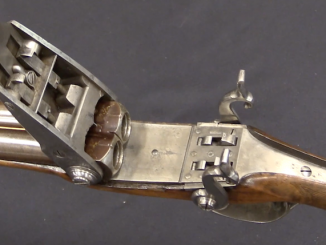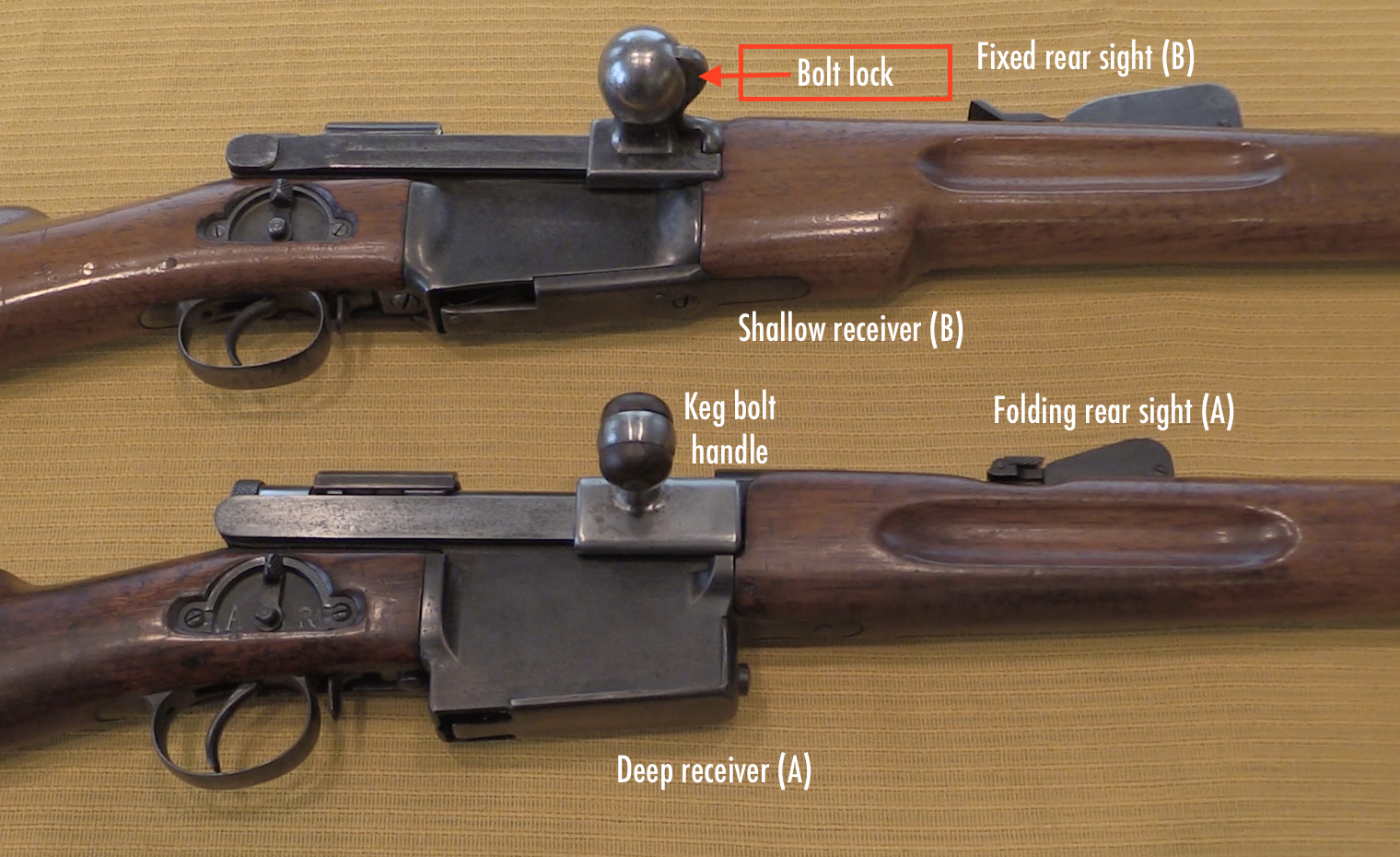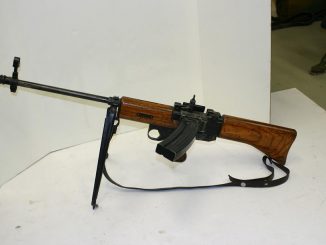This TB-41 antitank gun is being sold at Morphys on October 30, 2018.
Originally developed for use in light tanks purchased from Czechoslovakia, the Tankbuchse 41 was a 24x139mm semiautomatic rifle designed by Adolph Furrer of the Waffenfabrik Bern factory. Furrer was also responsible for the LMG-25 and MP41/44 used by the Swiss, and with the TB-41 he once again used the operating system he was most familiar with: a short recoil toggle locked action. The gun was ready and adopted in 1941, and a total of 3,581 were produced, used in light tanks, lake patrol boats, fortifications, and on wheeled carriages by the infantry.
High explosive and armor piecing projectiles were made, both weighing 3475 grains (225g) and with muzzle velocities between 2800 and 2950 fps (860-900 fps). The armor piercing round could perforate 30cm of perpendicular armor plate at 500m – more than most other contemporary antitank rifles. Designed specifically for rapid fire, the gun fed from 6 round magazines, and automatically ejected the magazine when the last round was chambered, so that the crew could reload it without having to run the chagrin crank handle. The guns never saw combat use, and by the end of World War Two were being pulled back out of inventory and relegated primarily to fortress use.




Huh, there is few problems with units used.
“2800 and 2950 fps (860-900 fps)”
This is mutually exclusive, should be: 860…900 m/s.
“armor piercing round could perforate 30cm of perpendicular armor plate at 500m – more than most other contemporary antitank rifles”
I presume it should be 30 mm rather than 30 cm, as latter means 300 mm, which is even more than WW2 German 12,8-cm-PaK 44, that penetrated 212 mm at 500 m using PzGr. 43.
Well that much seems obvious. But I would hate to encounter such a weapon while driving a lightly armored scout vehicle! Considering that tanks and mountains generally don’t go well together, forget bringing your medium or heavy tanks. I also remember you shouldn’t charge up the mountain when the defending troops have lots of artillery support… to say nothing about aircraft piloted by guys who know the terrain better than most invaders! The Swiss were indiscriminately hostile and tended to charge any unwelcome guests a very nasty bill of internment services (including the fact they didn’t kill you!). I could be wrong!
Also Tankbüchse not Tankbuchse.
Some additional photos: http://tankarchives.blogspot.com/2017/10/tankbuchse-41-rifle-or-cannon.html
Interestingly, as one photo description claims The Tankbüchse 41 could be towed by a cyclist.. However now I am wondering how heavy it must to move uphill with such trailer, also doing downhill with such trailer, presuming it had not wheels brake, must be… exciting experience.
Unfortunately, most word processor programs used in the U.S. do not allow umlauts, or the Eszett/scharfes S.
cheers
eon
Yes they do if you take spelling auto-correct off. Or you could also mark the text as German, which will automatically exclude it from English spell checking.
Windows and Macintosh word processor have used Unicode character encoding for almost 20 years. So not only you can use national expanded versions of Latin alphabet but even used non-Latin scripts such as, let’s say, Devangiri if you need to. The standard fonts do not necessarily have those characters, but they do have everything used in European languages, even Cyrillic.
Pretty sure the bicycle photo is a joke.
This bike has a coaster brake rear and a rod brake front, and a single gear of about 2,5 (standard swiss army bike). Nice for riding in Amsterdam, but a real challenge in Switzerland even without any extra load, up AND down-hill (been there). They only got bikes with gears and brakes in the 90’s, but only 7 speed, most of them to big, on an 18 kg bike!
Bicycle/ “Fahrrad” vs. tank! Love it.
I’d agree that with a coaster brake on the 1905 Ordonanzrad and the crazy “spoon brake” of the front–common to German military bicycles too!–that would be a bit of a load. On the other hand, it seems that the bicycle was pushed uphill, ridden downhill, and suitable for moving along reasonably level rural roads. A good vehicle for a militia-type armed forces like Switzerland has long had, although I’d think Belgium, the Netherlands, and Demmark should arguably still have bicycle troops.
Those 7-speed mountain bikes that came out in the ’90s are nutty all right!
Make mine two panzerfaüste 100m on either side of the front fork thank-you-very-much, erm, danke schön! Merci beaucoup! Grazie! Grazia!
What the heck are you babbling about?
Daweo:
You have put your finger on one of the failings of the metric system. It is very logical, but it also very easy to get your measurements out by an order of magnitude. If you mistake a kilogramme for a gramme you end up with 1000 times more than you wanted!
People have actually died because doctors have prescribed the wrong amounts of drugs by mistake. If you are meant to have a microgramme of drug, you don’t want a milligrame do you?
At least if your units are an inch, a foot and a yard, you never get them mixed up.
True but mistakes made on orders of magnitude like that are made by people who really aren’t thinking straight, have not really learned about metric unit prefix letters, or have really bad penmanship! Believe me, I was irked by the way most people seem to ignore the difference between units of force, energy, and mechanical work/power. They just don’t understand the underlying math and it’s worse when undergraduates in aeronautical/mechanical studies forget to convert horsepower into foot-pounds-per-second!!
Measurement system used might be often explained via history
https://www.reddit.com/r/polandball/comments/23fcs4/the_metric_system/
and using incompatible system might have unwanted results
https://www.reddit.com/r/polandball/comments/23g0dg/the_metric_system2/
In fact there exist so-called natural units, which are derived from physical constants: https://en.wikipedia.org/wiki/Physical_constant#Natural_units
“horsepower”
Wait, which horsepower, as there exist mechanical horsepower and metric horsepower (1 metric horsepower is needed to lift 75 kg to height of 1 m in time of 1 second). Additionally to encourage confusion so-called tax horsepower were introduced in several countries: https://en.wikipedia.org/wiki/Tax_horsepower
Notice that United Kingdom system which applied tax based solely on pistons area promoted long thin cylinders.
Mechanical horsepower from the English unit system must be converted into foot-pounds per second before any performance figures can be calculated for any given aircraft (you need the actual numbers and some calculus on some performance equations to determine the aircraft’s maximum operating altitude). My professor made it clear that the full answer wasn’t in the answer key to our textbooks! And yes, it was a “power-required” equation set we used for maximum altitude of flight…
“If you mistake a kilogramme for a gramme you end up with 1000 times more than you wanted!”
But then there is also chance to confuse metric AND imperial system, which once ended so:
https://en.wikipedia.org/wiki/Air_Canada_Flight_143
(note that jetliners used 1980s might glide, but were never optimized for that, so while fuel starvation was not certain death, it was surely at least uncomfortable for pilots)
“Furrer was also responsible for the LMG-25 and MP41/44 used by the Swiss”
He also created 7,5 mm [7,5×55 GP11 cartridge] for aviation use, about 5700 examples made. It was used both in fixed and flexible roles, in first both as wing-mounted and synchronous (firing through propeller arc). In second either single or twin mount. This machine gun was derivative of earlier Lmg-25, but it differed, main differences are as follows (aviation vs ground): firing from closed bolt vs open bolt, belt-fed vs magazine-fed, Rate-of-Fire was 1100-1300 rpm in aviation machine gun, feeding via 200-round belt or 250-round belt. It can be fed from either side (i.e. belt movement direction might be from left to right or from right to left). Based on this weapon twin AA machine gun was created featuring water cooling.
Data from, you can also photos: http://www.airwar.ru/weapon/guns/flabmg29.html
He also created 20 mm aircraft autocannon, which was also adopted for AA usage and 34 mm (yes, 34 mm, untypical caliber) AA automatic cannon. Both these weapons were also using Furrer toggle system. 20 mm fired 400 rpm and used 20×138 Furrer cartridge (this is NOT 20×138 Long Solothurn), while 34 mm fired 250…350 rpm and used 34×239 cartridge. Bigger weapon was liquid cooled.
Data from, again with photos: http://www.airwar.ru/weapon/guns/fmk38.html
Interestingly it seems cartridges outlived original weapons, 24×139 cartridge:
http://municion.org/24/24x139FurrerM55.htm
was apparently produced yet in 1978 for tank gun training, while 20×138 for Flab K-38 was developed into 20×139 Hispano Suiza 820 — these cartridge differs very little, second one has thicker rim to function properly in much faster /higher Rate-of-Fire/ weapon namely 20mm M139 Gun firing 1000 rpm.
While the armor penetration of this weapon was fairly impressive for its weight, it was still obsolescent by 1942. It was also too heavy to be carried by two men, unlike the Lahti or S18-1000, which would have limited its tactical mobility and use. Now, admittedly Switzerland has plenty of places for flanking ambush positions for tanks and they managed to make a large number of them, so they would not have been completely useless even after 1941.
I’m not surprised about the ambush uses. Even obsolete artillery was found to have its uses whenever the element of surprise was included. Admittedly, invading armies would have a hard time shoving heavily armored tanks across Switzerland. I can’t imagine just how bad a Tiger 1 would fare on the mountain roads, especially if the Swiss also used lots of anti-tank mines along with anti-tank gun barrages.
Switzerland is both an excellent place for artillery indirect-fire support of defense, and a horrible place for artillery indirect-fire support of offense.
During the advance up the Italian boot in December of ’44, Allied artillery units found themselves dealing with the German defenses of the Gothic Line, which were mainly on the heights of a mountain chain. As such, there could be as much as 4,000 feet of vertical displacement between the gun and the intended target. This often required setting a “false range” and charge adjustment to actually get a round anywhere near the target.
The defending German artillery had no such problems, as having been dug in there for some time they had had the time to pre-register almost all the likely places that artillery or anything else would be sited on the south side of the Line.
Switzerland’s terrain is significantly more mountainous than northern Italy. As such, I would expect the Wehrmacht, or anybody else, invading Switzerland to have similar problems to those confronting Allied artillery at the Gothic Line. Except probably worse.
cheers
eon
“Except probably worse.”
For example see photos of these Swiss gun turrets: http://www.festungswelt.de/schweiz/san_carlo.htm
notice camouflage, which make it looks to be stone. These turrets are bearing 10,5 cm-caliber guns and are heavily armoured, overall mass of moving part is 50 tons, while armour is “equivalent to 350 mm of steel”. So even if you manage to detect such turret and hit it with own field artillery it might remain operational anyway.
In other words, the turret crew gets angry about the headache, mathematically pinpoints the source of the shot, and sends a reply in the form of explosive payload!
Not unless they have modern counterbattery radar… You could get a very approximate position of enemy artillery by acoustical triangulation methods and comparing muzzle flashes to sound at night, but pinpointing it required direct observation by aircraft or scouts.
As a weapon on a smallish patrol boat, I can see one of these messing some stuff up, as they say……
The 24 x 139 round was impressively powerful for its compact dimensions – I’m surprised the Swiss didn’t use it in other warlike ways (e.g. aircraft cannon). You can see almost all anti-tank rifle ammunition in this article on my website: http://quarryhs.co.uk/ATRart.htm
There is a photo of the gun being towed by a bicycle on page 219 of my book “Rapid Fire”. No suggestion that it was a joke.
It probably would have been non-trivial to design a light enough gun with a high rate of fire for aircraft use. The closest historical equivalent would probably be the Soviet 23mm VYa, which was good for ground attack, but less so as fighter armament.
The Swiss also already had a 34mm AA gun, so another AA gun with only 10mm difference in caliber was probably not needed.
“closest historical equivalent would probably be the Soviet 23mm VYa”
In terms of case dimensions I agree, but in terms of ballistic its closer equivalent is, also Soviet, 25×218 rimmed cartridge, as used in: https://en.wikipedia.org/wiki/25_mm_automatic_air_defense_gun_M1940_(72-K)
According to Russian wikipedia query:
FRAG-IT: 288 g projectile at 910 m/s
APC-T: 28 g projectile at 900 m/s
72-K gun production ceased in 1945, but based on this cartridge rimless cartridge was created: http://municion.org/25/25x219Navy.htm
which was used by Soviet Navy in 110-ПМ and М-110 guns, first one is short-recoil operated belt-fed weapon firing 270…300 rpm, second used combined operation principle (it is short-recoil, but has gas-port, as powdered gasses are used to accelerate movement of parts from opened to closed) and thus is firing 470…480 rpm.
For photos see: http://weaponsystems.net/weaponsystem/II02%20-%2025mm%202M-3.html
““closest historical equivalent would probably be the Soviet 23mm VYa”
In terms of case dimensions I agree, but in terms of ballistic its closer equivalent is, also Soviet, 25×218 rimmed cartridge”
I’d go with the VYa as the closest:
24 x 139 Tb 41= 225 g AP at 900 m/s, 91,000 J muzzle energy
23 x 152B VYa = 199 g API at 890 m/s, 79,000 J
25 x 218R M1940 = 288 g at 910 m/s, 119,000 J
There was also an experimental French 23 x 122 in the late 1930s, for the Hispano HS 406 and 407 aircraft guns:
200 g at 900 m/s, 81,000 J.
Epic militaria in England has a nice range of 1940s Swiss military bicycles, if the purchaser of this gun wants to be mobile.
https://www.epicmilitaria.com/catalogsearch/result/?cat=0&q=bicycle
Ignore my last comment about the bike photo – it’s the same as the one on t’other site.
Yowza! “weapon of choice” scenario?
So here I’m seconded to the narrow gauge railway through the tunnel. The tiny locomotive tractor making its heaving “pocketa-pocketa-pocketa” noises amplified by the cavernous interior of the mountain side.
We’re dragging a few 5.3cm Schumann-Gruson “Fahrpanzer” turrets to the point where the tracks are blasted. Then comes the laborious procedure of transferring them, the giant defensive flame thrower/flammenwerfer to the horse-drawn/ mule drawn transports along with the gulaschkanone, and up the mountain sides we go! The enemies’ reconnaissance has seen no defensive installations, and so now we’ll move them into place unexpectedly… Wouldn’t one of these tankbüchse ein-und-vierzig be a good contribution to the defense installations covering the defile?
Yes, it would stand to reason that a tank-killing “heavy rifle” would cover the area from a defilade position. The other team will find it hard to shoot back, unless they call in planes (and good luck doing that if the planes are choking to death in the thin mountain air).